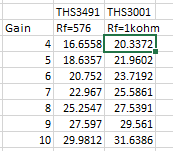Other Parts Discussed in Thread: THS3491
Hi I'm trying to do a thermal analysis and see typical input bias drift but can you let me know the worst case value ?
Thanks,
Steve
This thread has been locked.
If you have a related question, please click the "Ask a related question" button in the top right corner. The newly created question will be automatically linked to this question.
Hello Steve,
Great question! For specifications such as input bias current, on some parts TI specifies a T = 25C value as well as an extended or 'full [temperature] range' value. For the THS3001, the maximum value listed at T = 25C is the 'typical' usage condition for the amplifier. For the 'full range' listing, the Ib value is increased to reflect the 'worse temperature case', to Ib = 15uA.
I would use 15uA as your 'worst case' for you analysis; this value is labelled over the full range of the THS3001, which covers extreme temperature values.
Please see this prior E2E thread as well for a reference to this same train of thought: https://e2e.ti.com/support/amplifiers-group/amplifiers/f/amplifiers-forum/860177/opa4172-q1-input-bias-current-worst-case-analysis
Best,
Alec
Thanks Alec,
That's a useful guideline unfortunately my main concern is input offset voltage drift which is specified as 5uV/C but there is no full range value to use. So do you have a worst case number of a suggestion like rule of thumb multiplier ? Whatever you can suggest so that I can fully tolerance deign thermally.
Thanks,
Steve
hey Steve, it is unkilkely you are going to get much of a definitive reply on such an old part. Being CFA, DC terms are not particularly good. One practice that is common on specs that should be centered at 0 is to report the typcial value as +/-one sigma. Not as true on CFA's, but one estimate would be 4sig for worst case or +/-20uV/C.
Thanks Mike, that's a useful rule of thumb. I did find an old post on this forum with actual six sigma values which came out as 24.5uV/C so pretty close. By the way had to go back to the THS3001 because THS3491 although a nicer newer part is noisier.
Thanks Mike, that's a useful rule of thumb. I did find an old post on this forum with actual six sigma values which came out as 24.5uV/C so pretty close. By the way had to go back to the THS3001 because THS3491 although a nicer newer part is noisier.
Hello Steve,
I do understand now; your concern is with drift, for input offset voltage & input bias. Michael's response is accurate as to how I would be able to provide answers for the THS3001. I will ask around our design & apps teams to see if there are any insights from experience.
Could you confirm whether your interest is in
I also saw the note about noise on the THS3491; anecdotally for my sake, what are your noise targets for performance of the necessary CFA?
If you have additional questions or ideas for how to better address common questions, please provide a response to that end.
I will monitor the discussion and add-in any information I can regarding this matter .
Best,
Alec
Using one of my many noise calc tools, Here I am sweeping the total output Eo spot noise using fixed Rf, Yes, the Rf can be reduced at higher gains, but the point is the input terms are important, but so are the required resistors. I balanced all of these terms against the existing parts and required Rf values to try and make the the THS3491 as good or better for new designs. I used the spot noise numbers from the datasheets.

Hi Michael, I'd prefer the 3491 but in my application we need the lower current noise of 13/16pA RtHz and 1.6nV/RtHz of the 3001 Vs 15/20pA RtHz and 1.7nV RtHz of the 3491. Normally this wouldn't matter as an output stage but in our application it is quite noticeable. We even tried on two TI evaluation boards and can see the difference there too. My guess is higher power consumption for speed in the 3491 causes noise levels to be higher as well. Yes we could use lower resistor values and put up with higher power dissipation but we don't need the speed so 3001 seems to be the best fit quiet and everything runs nice and cool so reliability will be good.